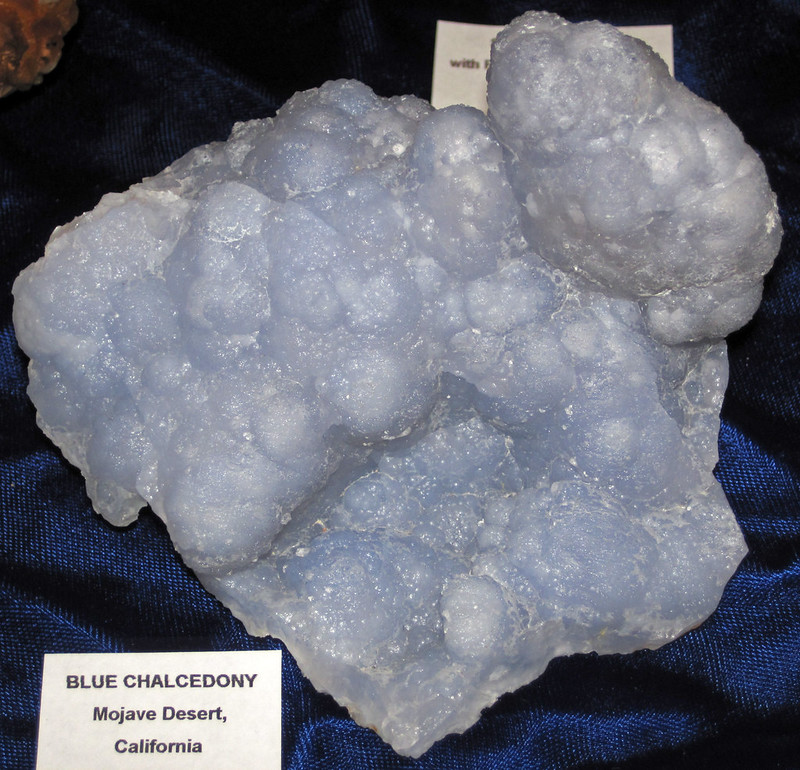Chalcedony
Chalcedony is a cryptocrystalline form of silica, composed of very fine intergrowths of quartz and moganite. These are both silica minerals, but they differ in that quartz has a trigonal crystal structure, while moganite is monoclinic.
Chalcedony has a waxy luster, and may be semitransparent or translucent. It can assume a wide range of colors, but those most commonly seen are white to gray, grayish-blue or a shade of brown ranging from pale to nearly black. The color of chalcedony sold commercially is often enhanced by dyeing or heating.
Etymology
The name chalcedony comes from the Latin chalcedonius (alternatively spelled calchedonius) and is probably derived from the town of Chalcedon in Turkey. In ancient Egypt, the stone's blue form was called herset hedj, while the green was perdjen.
The name appears in Pliny the Elder's Naturalis Historia as a term for a translucent kind of jaspis.
Varieties
- Carnelian - A clear-to-translucent reddish-brown variety.
- Bloodstone - Heliotrope is a green variety of chalcedony.
- Chrysoprase - Chalcedony that contains small quantities of nickel.
- Onyx - A variant of agate with black and white banding.
History of human use
Chalcedony was used in tool making as early as 32,000 years ago in Central Australia where archaeological studies at sites in the Cleland Hills uncovered flakes from stone brought in from quarries many kilometres away. Pre-contact uses described in the twentieth century included ceremonial stone knives.
In the Bronze Age, chalcedony was in use in the Mediterranean region; for example, on Minoan Crete at the Palace of Knossos, chalcedony seals have been recovered dating to circa 1800 BC. People living along the Central Asian trade routes used various forms of chalcedony, including carnelian, to carve intaglios, ring bezels (the upper faceted portion of a gem projecting from the ring setting), and beads that show strong Greco-Roman influence.
Fine examples of first century objects made from chalcedony, possibly Kushan, were found in recent years at Tillya-tepe in north-western Afghanistan. Hot wax would not stick to it so it was often used to make seal impressions.
In the 19th century, Idar-Oberstein, Germany, became the world's largest chalcedony processing center, working mostly on agates. Most of these agates were from Latin America, in particular Brazil. Originally the agate carving industry around Idar and Oberstein was driven by local deposits that were mined in the 15th century.
Spiritual use
Chalcedony is a nurturing stone that promotes friendship and goodwill. Its presence may enhance the stability of a group of people including family members, friends, or co-workers. The stone can be used to enhance telepathy and mental transmission. Chalcedony is capable of absorbing negative energy. Blue chalcedony is specifically good for protecting, healing, and otherwise nurturing the throat chakra.
According to Heinrich Cornelius Agrippa, chalcedony is a stone under the planets Saturn and Mercury together with the tail of Scorpio and Capricorn.
Biblical references
According to tradition, at least three varieties of chalcedony were used in the Jewish High Priest's Breastplate, which was worn by Moses' brother Aaron containing inscribed gems representing the twelve tribes of Israel. The Breastplate included jasper, chrysoprase, and sardonyx, and there is some debate as to whether other agates were also used.
Another religious reference to a gem by the name of khalkedon (χαλκηδών) is found in the Book of Revelation (21:19) as a precious stone decorating the walls of the city of New Jerusalem; however, it is a hapax legomenon found nowhere else in the Bible, so it is hard to tell whether the precious gem mentioned in Revelation is the same as the mineral known by this name today.
It is the stone of the Archangel of the Zodiac Muriel, who rules over the sign of Cancer.
